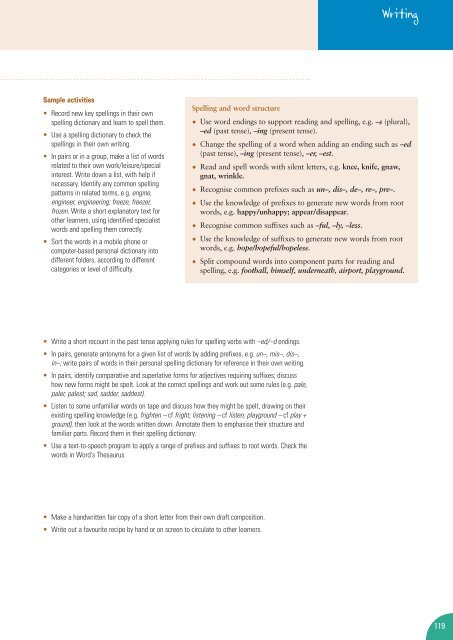Adult Literacy Core Curriculum - Nationally developed Skills for Life ...
Adult Literacy Core Curriculum - Nationally developed Skills for Life ...
Adult Literacy Core Curriculum - Nationally developed Skills for Life ...
Create successful ePaper yourself
Turn your PDF publications into a flip-book with our unique Google optimized e-Paper software.
Sample activities<br />
• Record new key spellings in their own<br />
spelling dictionary and learn to spell them.<br />
• Use a spelling dictionary to check the<br />
spellings in their own writing.<br />
• In pairs or in a group, make a list of words<br />
related to their own work/leisure/special<br />
interest. Write down a list, with help if<br />
necessary. Identify any common spelling<br />
patterns in related terms, e.g. engine,<br />
engineer, engineering; freeze, freezer,<br />
frozen. Write a short explanatory text <strong>for</strong><br />
other learners, using identified specialist<br />
words and spelling them correctly.<br />
• Sort the words in a mobile phone or<br />
computer-based personal dictionary into<br />
different folders, according to different<br />
categories or level of difficulty.<br />
Spelling and word structure<br />
• Write a short recount in the past tense applying rules <strong>for</strong> spelling verbs with –ed/–d endings.<br />
• In pairs, generate antonyms <strong>for</strong> a given list of words by adding prefixes, e.g. un–, mis–, dis–,<br />
in–; write pairs of words in their personal spelling dictionary <strong>for</strong> reference in their own writing.<br />
• In pairs, identify comparative and superlative <strong>for</strong>ms <strong>for</strong> adjectives requiring suffixes; discuss<br />
how new <strong>for</strong>ms might be spelt. Look at the correct spellings and work out some rules (e.g. pale,<br />
paler, palest; sad, sadder, saddest).<br />
• Listen to some unfamiliar words on tape and discuss how they might be spelt, drawing on their<br />
existing spelling knowledge (e.g. frighten – cf fright; listening – cf listen; playground – cf play +<br />
ground), then look at the words written down. Annotate them to emphasise their structure and<br />
familiar parts. Record them in their spelling dictionary.<br />
• Use a text-to-speech program to apply a range of prefixes and suffixes to root words. Check the<br />
words in Word's Thesaurus.<br />
• Make a handwritten fair copy of a short letter from their own draft composition.<br />
• Write out a favourite recipe by hand or on screen to circulate to other learners.<br />
Writing<br />
• Use word endings to support reading and spelling, e.g. –s (plural),<br />
–ed (past tense), –ing (present tense).<br />
• Change the spelling of a word when adding an ending such as –ed<br />
(past tense), –ing (present tense), –er, –est.<br />
• Read and spell words with silent letters, e.g. knee, knife, gnaw,<br />
gnat, wrinkle.<br />
• Recognise common prefixes such as un–, dis–, de–, re–, pre–.<br />
• Use the knowledge of prefixes to generate new words from root<br />
words, e.g. happy/unhappy; appear/disappear.<br />
• Recognise common suffixes such as –ful, –ly, –less.<br />
• Use the knowledge of suffixes to generate new words from root<br />
words, e.g. hope/hopeful/hopeless.<br />
• Split compound words into component parts <strong>for</strong> reading and<br />
spelling, e.g. football, himself, underneath, airport, playground.<br />
119

















